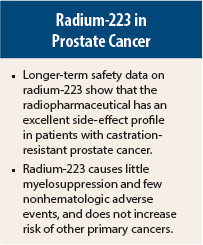Long-term follow-up of the ALSYMPCA trial showed that radium Ra 223 dichloride (Xofigo) is extremely safe and active in men with castration-resistant prostate cancer and bone metastases. A snapshot of safety data from about 1.5 years after patients’ final radium-223 injection shows minimal myelosuppression, minimal nonhematologic adverse events, and no reports of acute myelogenous leukemia, myelodysplastic syndrome, or primary bone cancer—all adverse events of concern.
“These safety data are reassuring and support further evaluation of radium-223 in combination with other agents to treat patients with [castration-resistant prostate cancer] and bone metastases,” said Sten Nilsson, MD, PhD, Professor of Oncology at the Karolinska Institute, Stockholm.
Radium-223 is a first-in-class alpha-emitting radiopharmaceutical recently approved by the U.S. Food and Drug Administration for treatment of patients with castration-resistant prostate cancer and symptomatic bone metastases, based on results of the pivotal phase III ALSYMPCA trial. In that study, radium-223 significantly improved overall survival by 3.6 months compared with placebo (P < .001), and the drug was very well tolerated.
ALSYMPCA enrolled 921 patients with castration-resistant prostate cancer and at least two symptomatic bone metastases (about two-thirds of patients had 6–20 bone metastases, and one-third had > 20) and no known visceral metastases. Patients had either received docetaxel or were not candidates for the taxane. They were randomly assigned 2:1 to radium-223 (six injections at 4-week intervals) or placebo.
Of 921 patients who underwent randomization, 574 entered 3-year follow-up (406 for radium-223 and 168 for placebo). Withdrawals from 3-year follow-up totaled 322 (79%) in the radium-223 group and 144 (86%) in the placebo group. Deaths were the most common reason for withdrawal.
Median duration of follow-up was 10.4 months for radium-223 recipients and 7.6 months for placebo recipients. Only 20 patients (16 in the radium-223 group and 4 in the placebo group) completed 3-year follow-up.
Adverse Events
The investigators reported only treatment-related adverse events during follow-up. The incidence of myelosuppression was very low in the radium-223 group during follow-up (< 3%). There were no grade 3/4 nonhematologic treatment-related adverse events for radium-223 except for one pathologic fracture (< 1%).
Data on secondary cancers were reassuring. There were no reports of acute myelogenous leukemia, myelodysplastic syndrome, or primary bone cancer. Five cancers in other organs were reported, two in the radium-223 group and three in placebo patients.
“No additional safety issues were reported 1.5 years after patients stopped treatment,” Dr. Nilsson reported. ■
Disclosure: Dr. Nilsson is a consultant or advisor for Algeta. For full disclosures of the study authors, visit abstracts.asco.org.
Reference
1. Nilsson S, Vogelzang NJ, Sartor AO, et al: 1.5-year post-treatment follow-up of radium-223 dichloride (Ra-223) in patients with castration-resistant prostate cancer and bone metastases from the phase 3 ALSYMPCA study. Genitourinary Cancers Symposium. Abstract 9. Presented January 30, 2014.



